
A sequence to relieve fatigue and stress, promote well-being, and bring healing balance into your life.
Restorative yoga might best described as a supported, conscious body/mind relaxation practice. When supported with props, the body relaxes and opens, releasing tension and stored-up toxins that can cause illness. Restorative poses offer benefits to both the body and mind, for conditions ranging from insomnia to asthma to chronic pain to migraines to depression.
Chest-opening poses, for example, encourage breath and prana (energy) to flow through the entire body. Forward bends gently lengthen all the muscles of the back body. Done in sequence, a restorative yoga practice will bring your whole body into a deeply relaxed state, and allow your mind to become quiet and reflective, with your mental, psychological, and emotional bodies in blissful balance.
Hints for Practice
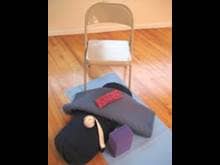 As you practice this sequence, let your mind soften into the sensations your body feels as it releases and opens. Immerse yourself in the journey from outer to inner experience, and you will find yourself at your center, where all the parts of yourself come into wholeness.
As you practice this sequence, let your mind soften into the sensations your body feels as it releases and opens. Immerse yourself in the journey from outer to inner experience, and you will find yourself at your center, where all the parts of yourself come into wholeness.Before we begin the sequence, here are some hints for practicing:
Passive Backbend
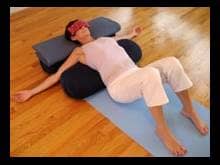 The Pose: Place a folded blanket or yoga bolster across your mat. Lie over the bolster with shoulders at the top, and support your head so that it's slightly higher than your chest. Bend your knees and place your feet flat on floor for more comfort in the low back area.
The Pose: Place a folded blanket or yoga bolster across your mat. Lie over the bolster with shoulders at the top, and support your head so that it's slightly higher than your chest. Bend your knees and place your feet flat on floor for more comfort in the low back area.The Benefits: Passive backbending gently opens the chest and upper back while softening and expanding the spinal muscles. The breath flows freely as the ribcage lifts and broadens. The neck and the throat soften and relax.
Reclining Butterfly Pose
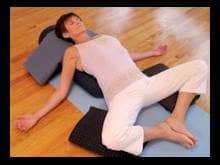 The Pose: Place folded blankets lengthwise under the spine. Bend your knees out to the sides and bring the soles of your feet together at the midline of your body, about six inches from your hips. Support your head so it's slightly higher than your chest. Support your thighs to reduce tension in the inner thighs.
The Pose: Place folded blankets lengthwise under the spine. Bend your knees out to the sides and bring the soles of your feet together at the midline of your body, about six inches from your hips. Support your head so it's slightly higher than your chest. Support your thighs to reduce tension in the inner thighs.The Benefits: This pose creates softness and muscular release in the legs, hips, and torso. Relaxes and opens the chest and heart area so that your breath becomes full, free and deep.
Supported Standing Forward Bend
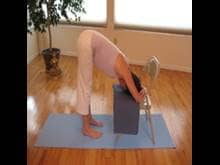 The Pose: From a standing position, bend forward from the hip joints and support your arms and the crown of your head on the seat of a chair. Place folded blankets on the chair to increase the height of head support, if desired.
The Pose: From a standing position, bend forward from the hip joints and support your arms and the crown of your head on the seat of a chair. Place folded blankets on the chair to increase the height of head support, if desired.The Benefits: This is a passive release for the torso. Feel a gentle stretch along the whole back of the body, reducing tension in the spine and legs. Allow the eyes to soften downward and inward and feel the mind becoming passive and quiet.
Supported Extended Leg Pose
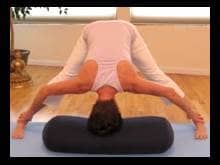 The Pose: Stand with your feet four to five feet apart. Bend forward from your hips and support your head on a block, bolster, or chair. Be sure your neck and throat are passive.
The Pose: Stand with your feet four to five feet apart. Bend forward from your hips and support your head on a block, bolster, or chair. Be sure your neck and throat are passive.The Benefits: Feel energy lift up through your legs as your spine descends towards the floor, elongating your legs and spine. As you bend forward, the kidneys and adrenal glands are opened and massaged, contributing to the health of the nervous system.
Supported Downward Facing Dog Pose
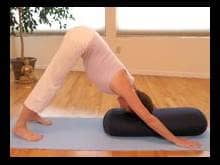 The Pose: Starting from an "all fours" position on your hands and knees, lift your hips and stretch them up towards the ceiling. Support your head on a block or bolster. If a partner is available, have your partner gently draw your hips up and away from your spine with a strap placed around the tops of the front thighs.
The Pose: Starting from an "all fours" position on your hands and knees, lift your hips and stretch them up towards the ceiling. Support your head on a block or bolster. If a partner is available, have your partner gently draw your hips up and away from your spine with a strap placed around the tops of the front thighs.The Benefits: The spine receives a deep stretch and the chest lengthens and opens in this pose. Space is created for each vertebra, massaging the spinal discs. The brain is cooled when the head is supported. This pose is also good for fatigue and headaches.
Supported Head-on-the-Knee Pose
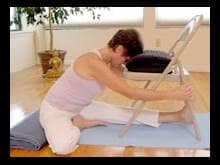 The Pose: Sitting with your hips on a folded blanket and with your legs straight forward, bend your right knee and place your right foot at your inner left thigh. Hold your left foot with your hands or with a strap. Support your head on a bolster or chair. Repeat on the other side.
The Pose: Sitting with your hips on a folded blanket and with your legs straight forward, bend your right knee and place your right foot at your inner left thigh. Hold your left foot with your hands or with a strap. Support your head on a bolster or chair. Repeat on the other side.The Benefits: Feel your back body lengthening. Holding your foot with your hands or a strap forms a continuous, flowing circle of energy through the body. As your range of sight is lessened in this forward bend, your eyes and mind are brought inward, becoming aware of the center of your self.
Supported Lying Twist
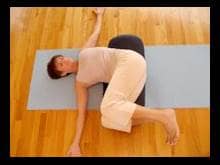 The Pose: Lie with your pelvis on a bolster with your knees bent, feet to floor. Draw the knees towards your chest one at a time, then with knees and feet together twist to the right, come back to the center, and twist to the left. In the twist, support your thighs on the bolster or add a blanket for more comfort. Keep your chest open and broad, your shoulders passive and grounded.
The Pose: Lie with your pelvis on a bolster with your knees bent, feet to floor. Draw the knees towards your chest one at a time, then with knees and feet together twist to the right, come back to the center, and twist to the left. In the twist, support your thighs on the bolster or add a blanket for more comfort. Keep your chest open and broad, your shoulders passive and grounded.The Benefits: Twisting is good after forward bending to release the spinal muscles and relieve any strain in the lumbar. Twists massage the abdominal organs and promote good digestion.
Inverted Cleansing Pose
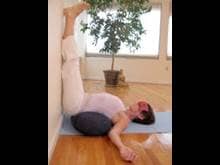 The Pose: Lie down and raise your legs up a wall. Your hips should be as close to the wall as possible. Bend your knees, place your feet flat on the wall, lift your hips, and place a bolster underneath them so that the bolster is 3-4 inches from the wall; then take the legs back up to straight. You know you're in the right position if your abdomen is soft and flat and your chest is open. You may stay with your back flat on the floor if the bolster creates discomfort in your lumbar.
The Pose: Lie down and raise your legs up a wall. Your hips should be as close to the wall as possible. Bend your knees, place your feet flat on the wall, lift your hips, and place a bolster underneath them so that the bolster is 3-4 inches from the wall; then take the legs back up to straight. You know you're in the right position if your abdomen is soft and flat and your chest is open. You may stay with your back flat on the floor if the bolster creates discomfort in your lumbar.The Benefits: This inverted pose reverses the flow of blood and energy and rejuvenates the whole body. The heart rests in an open position while breath flows freely through the torso. The chin is slightly tucked, giving a gentle massage to the glands in the throat and chest. This is a wonderful pose for balancing the endocrine system.
Supported Child's Pose
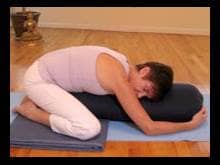 The Pose: Lay a blanket horizontally across your mat, and sit on your heels with your knees slightly wider than hip distance apart. Place folded blankets or a bolster between your legs (but not underneath your buttocks). Fold forward at your hips and support your torso on the bolster. Turn your head to one side for a few minutes, then to the other side to balance the neck.
The Pose: Lay a blanket horizontally across your mat, and sit on your heels with your knees slightly wider than hip distance apart. Place folded blankets or a bolster between your legs (but not underneath your buttocks). Fold forward at your hips and support your torso on the bolster. Turn your head to one side for a few minutes, then to the other side to balance the neck.The Benefits: This resting forward bend allows you to experience the benefits of bending forward without the distraction of tight hamstrings. The abdomen is massaged, the diaphragm stays wide and soft, and the spine lengthens and releases in this pose.
Deep Relaxation
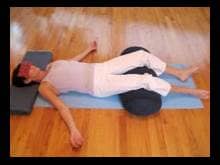 The Pose: Lie down comfortably on a mat or blanket. Support your head on a folded blanket so that your neck and throat are soft, adding a rolled up hand towel under your neck if needed, and support your knees on a bolster to lengthen and release your low back. Release your shoulders away from your neck and allow your arms and legs to completely relax. Breathe softly and naturally, focusing your mind on the sensations of the flow of breath through your opened and relaxed body.
The Pose: Lie down comfortably on a mat or blanket. Support your head on a folded blanket so that your neck and throat are soft, adding a rolled up hand towel under your neck if needed, and support your knees on a bolster to lengthen and release your low back. Release your shoulders away from your neck and allow your arms and legs to completely relax. Breathe softly and naturally, focusing your mind on the sensations of the flow of breath through your opened and relaxed body.The Benefits: Deep relaxation is the true gift of yoga practice. The soft and natural flow of breath energy through every part of your body allows you to move into a state of complete stillness, while your mind becomes deeply quiet through its attention to the flow of inner energy. Thoughts and emotions soften and lose their power. You become centered in the knowledge of your true "Self," where wisdom, insight, and freedom are present.



Tidak ada komentar:
Posting Komentar